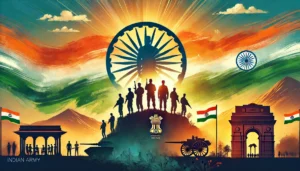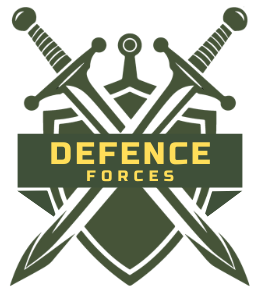defenceforcesindia.in
Selection procedure for Indian Army:The Indian Army is one of the most prestigious and respected institutions in India, offering a rewarding career to those who are ready to serve the nation. Understanding the selection procedure is crucial for aspiring candidates who wish to join the force. This guide outlines the complete process, including eligibility criteria, stages of selection, and preparation tips.
Eligibility Criteria
Before applying for any entry scheme, ensure you meet the eligibility criteria:
- Nationality: Indian citizens, subjects of Nepal, or individuals of Indian origin who have migrated from certain countries (like Pakistan, Sri Lanka, Myanmar) are eligible.
- Age Limit: Varies by entry type (NDA, TES, CDS, SSC, etc.)
- Educational Qualification:
- NDA: Passed or appearing in 12th standard (with Physics and Mathematics for Air Force and Navy).
- CDS: Graduation degree from a recognized university.
- Technical Entries: Engineering degree for technical positions.
- Physical Standards: Height, weight, and vision requirements as per Indian Army standards.
- Medical Standards: Candidates must pass a medical examination conducted by the Army.
Stages of the Selection Procedure
The selection process for the Indian Army is rigorous and includes multiple stages. These stages may vary slightly depending on the entry type, such as National Defence Academy (NDA), Combined Defence Services (CDS), Technical Entry Scheme (TES), or Army Cadet College (ACC).
1. Written Examination
- NDA & CDS: Conducted by the Union Public Service Commission (UPSC), these exams are held twice a year.
- NDA Exam: Includes subjects like Mathematics and General Ability.
- CDS Exam: Comprises English, General Knowledge, and Elementary Mathematics.
- Technical Entries (TES, UES): No written examination; candidates are shortlisted based on their academic performance.
2. Shortlisting
- For entries without a written exam (e.g., TES, NCC, UES), candidates are shortlisted based on their marks in the qualifying examination (10+2 or graduation).
- Shortlisted candidates receive a call letter for the next stage.
3. Services Selection Board (SSB) Interview
The SSB interview is one of the most challenging phases and lasts for five days. It includes the following:
Day 1 – Screening Test:
- Officer Intelligence Rating (OIR) tests.
- Picture Perception and Description Test (PPDT).
Day 2 – Psychological Tests:
- Thematic Apperception Test (TAT).
- Word Association Test (WAT).
- Situation Reaction Test (SRT).
- Self-Description Test (SD).
Day 3 & 4 – Group Testing Officer Tasks:
- Group discussion.
- Group planning exercise.
- Progressive group tasks.
- Half group task, lecturette.
- Individual obstacles, command task, and final group task.
Day 5 – Conference:
- The entire board assesses the candidate, and results are announced on the same day.
4. Medical Examination
- Candidates recommended by the SSB are required to undergo a thorough medical examination.
- This examination checks for physical fitness, vision standards, hearing, and overall health.
- Any medical conditions found are reported, and candidates may be given a temporary rejection with a timeline for rectification.
5. Merit List
- The final merit list is prepared based on performance in the written exam (if applicable) and the SSB interview.
- Candidates who rank high on the merit list and clear the medical examination are selected for training.
Types of Entries into the Indian Army
There are different entry schemes depending on the candidate’s educational background:
After 10+2:
- National Defence Academy (NDA).
- Technical Entry Scheme (TES).
After Graduation:
- Combined Defence Services (CDS).
- University Entry Scheme (UES).
- Technical Graduate Course (TGC).
Through Special Schemes:
- NCC Special Entry: For NCC cadets with ‘C’ Certificate.
- Short Service Commission (SSC): Technical and non-technical entries.
Preparation Tips for Indian Army Selection
- Focus on Physical Fitness: Regular running, strength training, and cardio exercises are essential.
- Prepare for Written Exams: Practice previous years’ papers, focus on time management, and strengthen your understanding of key subjects.
- Improve Communication Skills: Clear communication is crucial during the SSB interview.
- Stay Updated on Current Affairs: A good knowledge of national and international events helps in general awareness.
- Participate in Group Discussions: This enhances your ability to articulate thoughts and improves leadership qualities.
- Practice Psychological Tests: Familiarize yourself with TAT, WAT, and other psychological tests.
- Medical Fitness: Address any known medical issues beforehand and maintain a healthy lifestyle.
Training After Selection
Once selected, candidates undergo training at various military academies such as:
- NDA, Khadakwasla for NDA entrants.
- Indian Military Academy (IMA), Dehradun for CDS and TGC entries.
- Officers Training Academy (OTA), Chennai for SSC entries.
Conclusion
The selection procedure for the Indian Army is designed to assess candidates’ mental and physical abilities, leadership skills, and dedication. Aspiring candidates should prepare thoroughly for each stage, understand the requirements, and follow a disciplined routine to achieve success.
Indian Air Force Recruitment 2025: Apply Now for Agniveervayu (Sports) Intake 02/2025

CISF Recruitment 2025: Apply for 1124 Constable/Driver & Other Posts – Check Eligibility, Salary & Selection Process

Indian Navy Recruitment 2025: Apply Online for 270 Vacancies – Check Eligibility, Salary & Selection Process

Indian Army Recruitment 2025: Apply Now for 381 Vacancies Before 05 February

Ministry of Textiles Recruitment 2025: Apply for Junior Weaver, Junior Assistant, and Other Posts

Ministry of Finance Recruitment 2025: Apply for Inspector and Assistant Positions
Recent Posts
- Indian Air Force Recruitment 2025: Apply Now for Agniveervayu (Sports) Intake 02/2025 17 February 2025
- CISF Recruitment 2025: Apply for 1124 Constable/Driver & Other Posts – Check Eligibility, Salary & Selection Process 11 February 2025
- Indian Navy Recruitment 2025: Apply Online for 270 Vacancies – Check Eligibility, Salary & Selection Process 11 February 2025
- Indian Army Recruitment 2025: Apply Now for 381 Vacancies Before 05 February 19 January 2025
- Ministry of Textiles Recruitment 2025: Apply for Junior Weaver, Junior Assistant, and Other Posts 19 January 2025

